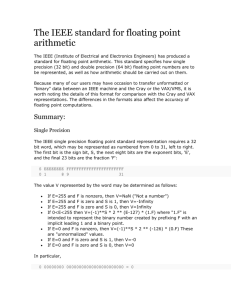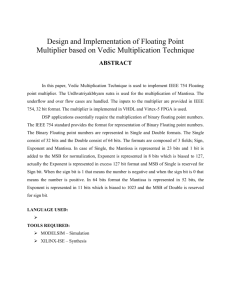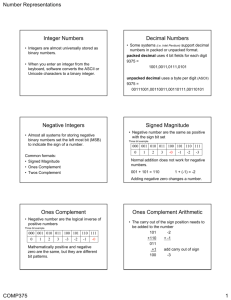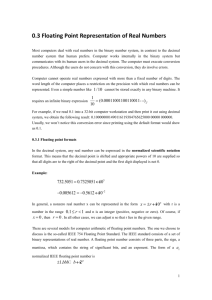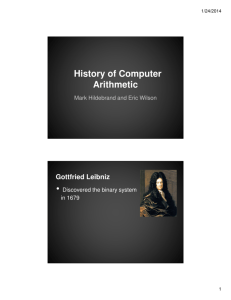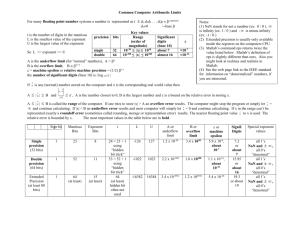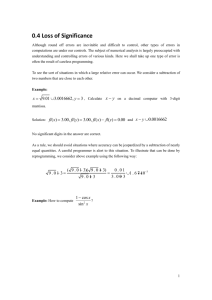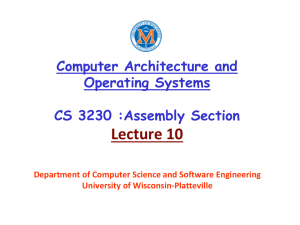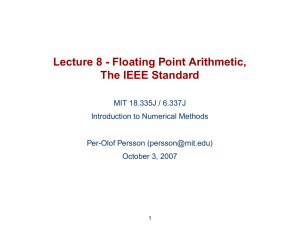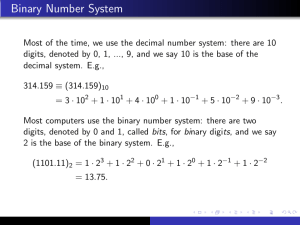Lecture #1: Floating Point Numbers
advertisement
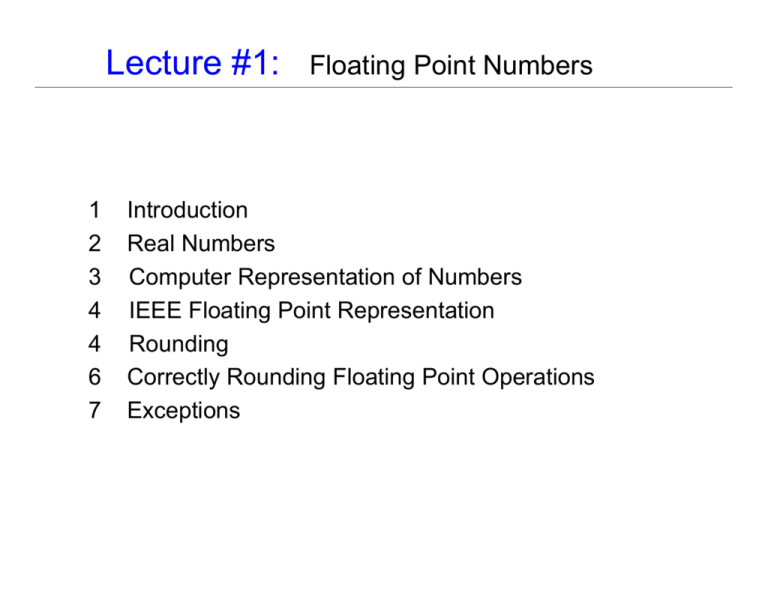
Lecture #1: 1 2 3 4 4 6 7 Floating Point Numbers Introduction Real Numbers Computer Representation of Numbers IEEE Floating Point Representation Rounding Correctly Rounding Floating Point Operations Exceptions Reference Numerical Computing with IEEE Floating Point Arithmetic written by Michael L. Overton published by SIAM Available at NYU Bookstore 1 Introduction: History of Computing • Number Systems & Tetrapods • Rhind Papyrus – Egyptian numerals (as Hieroglyphs) – Egyptian multiplication (as binary arithmetic) • Abacus – Background – Applet • First Stored Program Computer (EDVAC) • First Computer Bug 2 Real Numbers: • Integers, Rational, Irrational Numbers • Properties (Commutative, Associative, Distributive, Identity, & Inverse) • Zero – As Positional Place Holder – As a Number Itself • Complex Numbers 2 Real Numbers: Positional Number System • Baseless System (e.g., Roman Numerals) • Positional system (a.k.a. Digital System) – Base 60 (Babylonians … clocks, latitudes) – Base 10 (a.k.a. Decimal, Arabic/Indian) – Base 2 (a.k.a. Binary, Computerized Logic) 2 Real Numbers: Binary Conversion • Decimal to Binary – Decimal Fractions to Binary – Infinite Binary Fractions • Binary to Decimal 2 Real Numbers: Binary Arithmetic • Addition • Subtraction • Multiplication • Division 2 Real Numbers: Binary Bits • • • • • System Digits: 0 and 1 Bit (short for binary digit): a single binary digit Bitstring: a string of bits LSB (least significant bit): the rightmost bit MSB (most significant bit): the leftmost bit 2 Real Numbers: Binary Equivalents • 1 Nybble (or nibble) = 4 bits • • • • • • • • 1 Byte = 2 nybbles = 8 bits Upper Byte : right-hand byte of a pair Lower Byte : left-hand byte of a pair 1 Kilobyte (KB) = 1024 bytes 1 Megabyte (MB) = 1024 kilobytes 1 Gigabyte (GB) = 1024 megabytes 1 Terabyte (TB) = 1024 gigabytes 1 Petabyte (PB) = 1024 terabytes • • Word: 4 consecutive bytes of storage Double word: 8 consecutive bytes of storage 3 Comp. Rep. of Num.: • Logic Gates – Basic Functions – Binary Addition • History of Gate Size/Speed – – – – Vacuum Tube Transistor Integrated Circuit Microprocessor Logic Gates 3 Comp. Rep. of Num.: 2’s Complement • Most computers represent negative integers as 2’s complements • Algorithm – Express number in binary – Invert the digits – Add one to the result • Allows subtraction to be replace by (negative addition) • Worked example 3 Comp. Rep. of Num.: • Underflow • Overflow (ditto) Over/Under Flow 3 Comp. Rep. of Num.: • Fixed Point Number – A value with an integer and a fractional part • Fixed Point Arithmetic Fixed Point 3 Comp. Rep. of Num.: Scientific Notation • Express a real number x in scientific notation – where S is the mantissa (a.k.a. significand) – and E is the integer exponent • Decimal place ‘floats’ to position immediately after first non-zero digit in the decimal expansion of a number x = ± S × 10 E 1≤ S ≤ 9 3 Comp. Rep. of Num.: Floating Point x = ± S × 10 E • On a computer, we use base 2: • Binary expansion of significand is: (with • Also called normalized representation • Since bo = 1 ) 1≤ S ≤ 2 S = ( bo .b1b2b3 …) S = (1.b1b2b3 …) bo = 1 we represent significand as: – Leading bit is not explicitly stored (implied) 3 Comp. Rep. of Num.: Number Storage • Computer words shared into three fields (sign, exponent, and significant) • e.g., a 32-bit word shared as: 1 sign bit, 8 exponent bits, 23 significant – Sign bit (0 for positive; 1 for negative) – Exponent (represents -128 to 127) – Significant (stores first 23 bits after bo,, namely b1…b23 ) • Real number x exactly representable is a floating point number – Otherwise, real number must be rounded to next floating point number 3 Comp. Rep. of Num.: Precision • precision versus accuracy (scientific meanings) • precision (denoted p) of the floating point system is the number of bits in the significand (including the hidden bit). • Any normalized floating point number with x = ± (1.b b … b b ) × 2 E 1 2 p − 2 p −1 2 precision p can be expressed: 3 Comp. Rep. of Num.: • The smallest x such that x is greater than 1: • machine epsilon defined as the gap between the number above and 1 itself: Machine Epsilon x = ± (1.00… 01) 2 = 1 + 2 −( p −1) ε = ± ( 0.00… 01) 2 = 2 −( p −1) 3 Comp. Rep. of Num.: • Ulp is an acronym for ‘unit in the last place’ • Defined as: • For x > o, then ulp(x) is the gap between x and the next larger floating point number Ulp Ulp ( x ) = ± ( 0.00… 01) 2 × 2 E = 2 −( p −1) × 2 E = ε × 2 E 3 Comp. Rep. of Num.: • Zero cannot be normalized – the hidden bit is always implied to be 1 • Two solution strategies – 1) give up on concept of hidden bit and represent bo explicitly – 2) use special string in exponent field to signal the number is zero (IEEE approach) Zero 4 IEEE Floating Point: Institute(s) • IEEE – Institute for Electronics and Electrical Engineers • ANSI – American National Standards Institute – on-line store • (document 754-1985) The need for a standard – Portable code was elusive in the 1960s (prior to standard) – What every computer scientist should know about floating point arithmetic • Non-standard implementation – How Java’s floating point hurts everyone everywhere 4 IEEE Floating Point: Standard Requirements • Consistent representation of floating point numbers by all machines adopting the standard • Correctly rounded floating point operations, using various rounding modes • Consistent treatment of exceptional situations, such as division by zero 4 IEEE Floating Point: Special Numbers • Zero, and negative zero • Plus and minus infinity • Not a number (NaN) • How to represent these numbers in floating point – Special pattern of exponent field ? 4 IEEE Floating Point: Basic Formats • • • Single precision – 32 bit word Double precision – 64 bit double word Extend precision – (up to) 128 bit quad word • Minimum Range of numbers – Single : 2-126 ~ 1.2 x 10-38 – Double : 2-1022 ~ 2.2 x 10-308 • Maximum Range of numbers – Single : 2+128 ~ 3.4 x 10+38 – Double : 2+1024 ~ 1.8 x 10+308 • • Greater precision needed in some scientific calculations Lesser precision needed in some routine operations 4 IEEE Floating Point: • 32 bits available: – • Single Precision 1 bit sign; 8 bit exponent; 23 bit significand Special numbers: (zero and subnormal) – If exponent (00000000)2 = (0)10 – Then number (0.b1b2…b23) x 2-126 • Special numbers: (+/- infinity and Nan) – If exponent (11111111)2 = (255)10 – Then number +/- infinity if b1=b2…=b23=0 – Else Nan otherwise • Normal Numbers – Exponent is biased (need to subtract 127) – Examples of single precision standard (Pittsburgh Supercomputing Center) 4 IEEE Floating Point: • Subnormals Arises in situation of zero exponent (hence zero hidden bit) – If all fraction bits are zero, b1=b2…=b23=0 – Then the number is zero – Else a subnormal number is obtained • Can represent 2-127 through to 2-149 • Subnormals cannot be normalized – (if they did, the exponent would not fit in the exponent field) 4 IEEE Floating Point: • Double Precision 64 bits available: – 1 bit sign; 11 bit exponent; 52 bit significand • Conceptually identical to single precision • Examples of double precision standard (Pittsburgh Supercomputing Center) • Under what circumstances does user want single versus double precision ? – Scientific measurement ? – Scientific calculation ? 4 IEEE Floating Point: • Extended Precision 80 bits available: – 1 bit sign; 15 bit exponent; 64 bit significand • Differ from single/double precision in that no ‘hidden bit’ • • Intel implements extended precision in hardware (fast); Sparc implements in 128 bit software (slow) 4 IEEE Floating Point: • Single precision p=24 bits gives ~7 significant digits • Double precision p=53 bits gives ~15 significant digits • Single precision p=64 bits gives ~19 significant digits Significant Digits 4 IEEE Floating Point: • Big/Little Endian Given a single precision number is stored as a word (i.e., 4 contiguous bytes) – where to store sign bit and first seven exponent bits? (to the left or to the right of a 4 byte sequence) – To the left is BIG ENDIAN • (e.g., SUN, IBM) σ a1a2 ...a7a8b1b2 ...b22b23 – To the right is LITTLE ENDIAN • (e.g., Intel) • Important when passing data between different Endian computers (some example software) • Word Endian originates in reference to Gulliver’s Travels in discussion of which end of a boiled egg to open … the little or big end? 5 Rounding: Real Numbers ± (1.b1b2 … bp −2bp −1 )2 × 2 E • Finite IEEE floating point numbers: • Real number x is in the normalized range of the floating point system if: • If a real number x is not a floating point number, one (or both) of the following is true: – x is outside the normalized range (Nmax, Nmin) – binary expansion of x requires more than p bits to exactly specify the number N min ≤ x ≤ N max 5 Rounding: Neighbor Numbers x = ± (1.b1b2 … bp −2bp −1bp bp +1 …)2 × 2 E • Consider a real number: • The closest floating point number less than or equal is (obtained by truncating the significand) • The closest floating point number greater than or equal is (obtained by increment the least significant bit) • The gap between x- and x+ is ulp(x): x− = ± (1.b1b2 … bp −2bp −1 )2 × 2 E x+ = (1.b1b2 … bp −2bp −1 )2 × 2 E + ( 0.00… 01)2 × 2 E Ulp ( x ) = 2 − ( p −1) × 2 E 5 Rounding: Correctly Rounded Values • IEEE defines correctly rounded as being round(x) • Four rounding modes in effect: – Round down: • round(x)=x- – Round up: • round(x)=x+ – Round towards zero: • If x > 0 then round(x)=x• If x<0 then round(x)=x+ – Round to nearest: • round(x) is either x- or x+, whichever is nearer to x • In case of tie, the one with its least significant bit equal to zero is chosen 5 Rounding: Absolute Rounding Error abserr ( x ) = round ( x ) − x • Define absolute rounding error: • Consider a real number: • The absolute rounding error is less than the gap between x- and x+ x = ± (1.b1b2 … bp −2bp −1bp bp +1 …)2 × 2 E abserr ( x ) = round ( x ) − x < 2 − ( p −1) × 2 E • Absolute rounding error is less than one Ulp • When round to nearest in effect, then absolute rounding error is less than or equal to ½ of an Ulp abserr ( x ) = round ( x ) − x < 2 − p × 2 E 5 Rounding: Relative Rounding Error relerr ( x ) = δ • Relative rounding error (for nonzero x) is defined: • Relative error satisfies the bound: • For round to nearest we get: δ< δ= round ( x ) − x x round ( x ) − x 2 − ( p −1) × 2 E δ= < = 2 − ( p −1) = ε E x 2 where x > 2 E ε 2 round ( x ) = x (1 + δ ) • Theorem: • Thus, no matter how x is stored, we can think of its values as exact tihin a factor of 1+epsilon for some δ < ε
